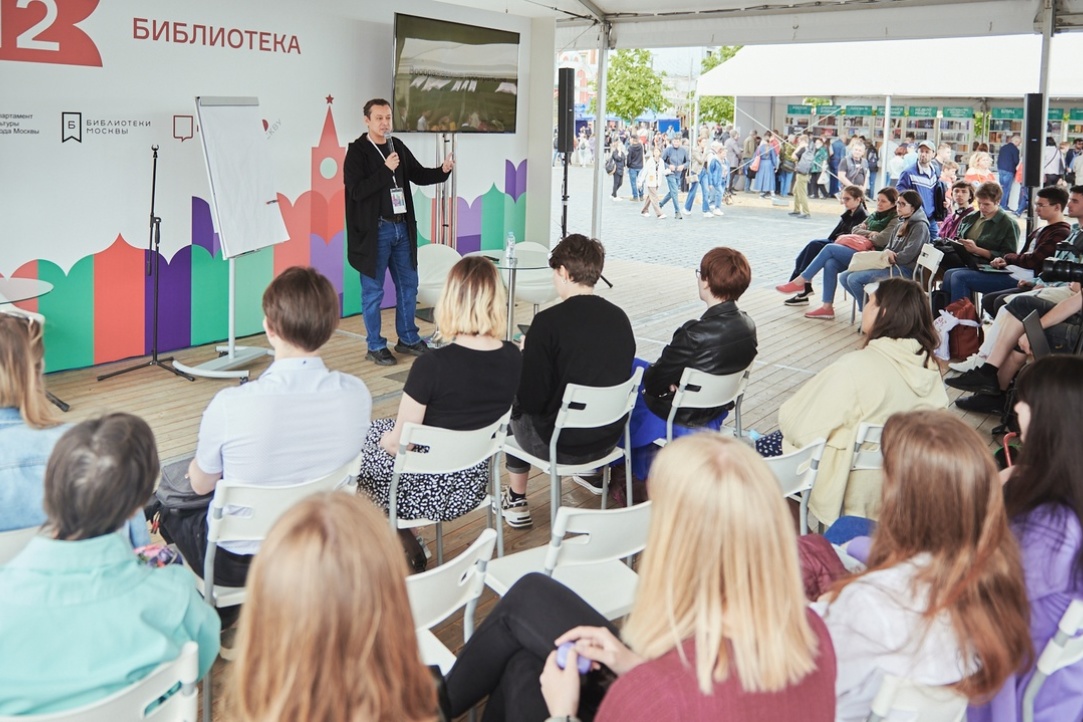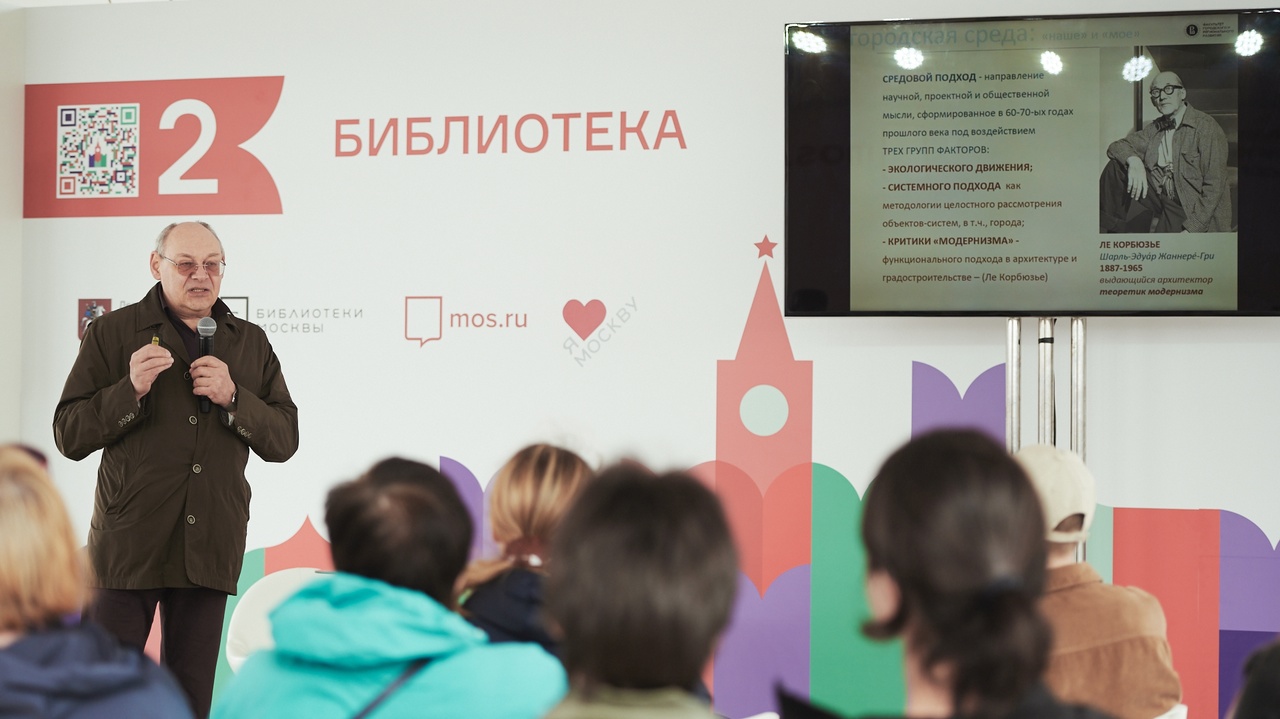A City in Your Mind: HSE Urbanists on Perceptions of Place and Imagined Neighbourhoods

Associate Professor Kirill Puzanov of the HSE Vysokovsky Graduate School of Urbanism and HSE University Professor Oleg Baevskiy have held lectures at the Red Square Book festival. They talked about perceptions of the city, its private and public aspects, chamber and representative spaces, and imaginary (or ‘vernacular’) areas. The open lectures took place as part of the HSE University Open to the City project.
Kirill Puzanov gave a guided tour of a ‘vernacular’ district. This is a mysterious place which is hard to find on a map—it is your subjective view of the space where you live, and your own idea of its extent and the distance between the objects within it.

‘A vernacular district reflects a resident's belonging to a particular territorial and social community,’ Puzanov explained. ‘Administrative districts are often too large for residents to address their identity to the whole district and feel a sense of belonging to all the processes taking place there.’
Vernacular districts in Moscow are often linked to metro stations, which were usually built on the borders between different administrative areas. As such, intracity vernacular districts may cross the borders not only of municipal districts, but also of administrative districts. For example, the ‘Universitet Metro Station’ vernacular district occupies territory in the Ramenki, Gagarinsky, and Lomonosovsky city districts.
Researchers study vernacular districts using mental maps, asking respondents to describe familiar places and comment on various objects. During his lecture, Kirill Puzanov presented a map of the city that included vernacular districts. It turns out that they do not fill all available space—there are empty spaces between them.
‘As a matter of fact, they don't have to cover the entire city area. This happens from time to time even in cities with an established neighbourhood system. The reason for this is twofold. First, areas without a distinctive image may not form a social community or vernacular neighbourhood around them. Second, it is important to understand that the borders of vernacular neighbourhoods are not a hairline that you cross to enter another reality. They are part of a gradient, a gradually changing environment. So, when we look at the map, we can assume that unallocated areas experience a gravitational pull towards their neighbours, and the right level of development enables an area to be included there over time,’ he explained.
Oleg Baevskiy went deeper into the topic of the relationship between people and the city. Our environment can be represented as a ‘core’, something stable that does not require constant concentration, while the ‘periphery’ is something changeable, mobile and diverse. To regular inhabitants, the ‘core’ is home, the point of reference for private behaviour. It is where we feel at ease and free. The ‘periphery’ includes places such as the city centre or our office. Actions there require tension and attention, creating a sense of urban activity.

‘It is theoretically possible to fully adapt to the “periphery”,’ said Prof. Baevskiy ‘There, city dwellers are interested in everything that is different from the “core”—from themselves. Full adaptation to the “periphery” means a complete loss of oneself, one's individuality. The “core” means no individuality, the “periphery” means no differences from it.’
Exchange between the ‘core’ and the ‘periphery’ is a necessary part of the development of urban dwellers, noted Oleg Baevskiy. Closure and the immutability of the ‘core’ is a falling out of this process, a loss of adaptive properties of the environment. At the same time, a balance is important, because full openness of the ‘core’ causes instability, which threatens the loss of orientation in the social space.
The attractiveness of the city as a whole is influenced by the proportionality of the urban environment to people, its development and safety, cultural identity, and diversity of the environment. Prof. Baevskiy noted that it is possible to expand the diversity of the environment by giving different parts of the territory and facilities their own individuality and uniqueness through names, the external appearance of facilities and their inhabitants, events, etc.
The researcher also spoke about the ‘poles’ of the urban space: which can be representative or chamber, public or private. They define appropriate forms of behaviour and attitudes towards others. For example, we understand how to behave on Red Square and how to behave in the small courtyard of an apartment building. In urban life, certain types of behaviour are consistently associated with spatial configurations and sets of things.
The lectures by the professors of HSE Vysokovsky Graduate School of Urbanism promoted discussion among the audience, which reflects the growing popularity of urbanism as a discussion topic in recent years.
See also:
Researchers at HSE University Identify the Most Walkable Areas in Moscow
Experts at HSE University and Lomonosov Moscow State University examined the available data on Moscow's walkability and found the central and south-western parts of the city to be more walkable than others. However, the eastern and south-eastern areas are in need of improvements to make them more pedestrian-friendly. The study has been published in Cities.
HSE University Urban Planners Take Part in Global Mayors’ Forum in Guangzhou, China
A team from HSE University's Faculty of Urban and Regional Development took part in the Global Mayor’s Forum—a global event in urban development. Held in December 2023 in Guangzhou (PRC), the largest congress of urban planners brought together more than 800 guests from 65 cities and 37 countries, as well as nine international organisations.
Card File: Travel Diary
Optimising a city's transportation system requires insights into the dynamics of urban traffic to understand where, how, when, and to what extent people travel within the city. The rationale behind route selection and the choice of transportation mode are also of importance. The primary source of this data is the travel diary, a tool designed to survey people's transport behaviour. Based on a paper by Maria Sergienko, a master's student of the HSE Faculty of Urban and Regional Development, IQ.HSE examines how people's daily travel can be described in detail and why an automated diary cannot yet completely replace its manual counterpart.
‘Seeing Moscow Ranked First among the Cities of BRICS Countries Is Pleasant, but Not Surprising’
An international consortium of research organisations from China, India, and Russia, including HSE University’s Faculty of Urban and Regional Development represented by experts from the Vysokovsky Graduate School of Urban Studies and Planning and the Centre for Social Research and Technological Innovation (CITY), is developing an index of technological and spatial urban development (the Urban & Innovation Environment Index). Recently, a list of the top 10 largest cities of the BRICS countries was published on the project’s website. The Russian capital took the first place in the ranking, followed by Beijing, Shanghai, Sao Paulo, and Guangzhou.
Summer University 2023: ‘A Good Introduction to Urban Studies’
At the start of August, HSE University held the tenth annual Summer University. This year’s programme took the form of a workshop on urban studies. The participants attended four courses from HSE University faculty and invited experts and worked on their own projects to develop a cultural heritage site. Jung Woo Lee, from South Korea, shares his impressions of the Summer University.
‘The Virtual City Is Joining the Real One at the Forefront’
HSE University has launched enrolment in a new online Master’s programme in Digital Urban Analytics. In this interview, the programme’s Academic Supervisor Ekaterina Zarudnaya and its Scientific Supervisor Kirill Puzanov speak about the processes and tasks generated by the online city, the demand for urban analysts, and the specifics of studying in the programme.
Two Worlds of Residents: Car Owners Look at Shared Urban Courtyards Differently from Pedestrians
Researchers from HSE University and St. Petersburg State University of Architecture and Civil Engineering (SPSUACE) used eye tracking to study how residents who own cars and those who don’t look at the shared courtyards of multistorey apartment buildings. The study was published in Urban Forestry & Urban Greening.
Back to the Future: Is Manufacturing Returning to Cities?
Are cities set to become industrial centres again? Are migrants integrating in Russia? How are city dwellers taking advantage of micro-mobility? Experts from the HSE Faculty of Urban and Regional Development (FURD) took part in Moscow Urban Forum. This year the topic of the Forum was ‘Superstar Cities: Transforming for Success’.
‘It Takes a Team to Develop a City’
What is urban planning? What is the ‘stranger effect’ and why do we need a multidisciplinary approach in education? School Head and Associate Professor Kirill Puzanov spoke with the News Service about what students learn and how in the Vysokovsky Graduate School of Urbanism, which celebrates its 10th anniversary this year.
‘My Entire Two Years of Studying at HSE University Were Very Happy’
Maria Melnikova, a graduate of the HSE Vysokovsky Graduate School of Urbanism Master’s programme inUrban Development and Spatial Planning, has written a book entitled Not Just Prefabs: The German Experience of Working with Mass Housing Neighbourhoods. She describes how Germany investigates and solves problems of housing in the city suburbs. Maria spoke with the HSE News Service about her interest in this topic, what she thinks about urban renewal and what she does in Berlin.


